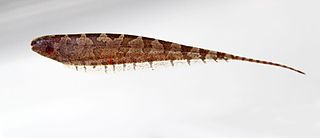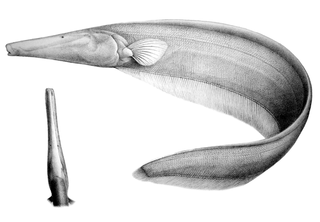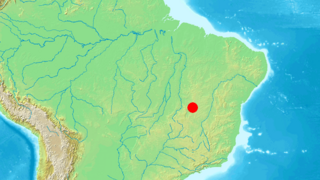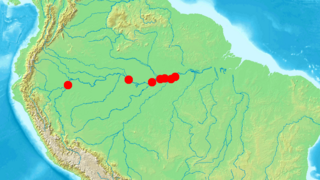
The Gymnotiformes are an order of teleost bony fishes commonly known as Neotropical knifefish or South American knifefish. They have long bodies and swim using undulations of their elongated anal fin. Found almost exclusively in fresh water, these mostly nocturnal fish are capable of producing electric fields to detect prey, for navigation, communication, and, in the case of the electric eel, attack and defense. A few species are familiar to the aquarium trade, such as the black ghost knifefish, the glass knifefish, and the banded knifefish.

The ghost knifefishes are a family, Apteronotidae, of ray-finned fishes in the order Gymnotiformes. These fish are native to Panama and South America. They inhabit a wide range of freshwater habitats, but more than half the species in the family are found deep in rivers where there is little or no light.

Sand knifefish are freshwater electric fish of the family Rhamphichthyidae, from freshwater habitats in South America.

The Hypopomidae are a family of fishes in the order Gymnotiformes known as the bluntnose knifefish. They may also be called grass or leaf knifefishes. These electric fish are not often eaten, of little commercial importance, rarely kept as aquarium fish, and poorly studied; however, species in this family may constitute a significant fraction of the biomass in the areas they inhabit.

Hypancistrus is a genus of loricariid catfish originating from the Amazon basin in South America. Unlike many of the other Loricariids, however, some Hypancistrus species are more carnivorous and enjoy meat in their diet. Hypancistrus species are popular aquarium fish, including such popular fish as the zebra pleco and Queen Arabesque pleco.

Magosternarchus is a genus of weakly electric knifefish in the family Apteronotidae, containing two species. They are endemic to Brazil, occurring in large river channels in the Amazon River basin. Both species are unusual benthic predators that specialize in biting off the tails of other knifefishes, and are characterized by their greatly enlarged jaws and teeth. Recent systematic studies indicate that both species should be included in Sternarchella instead of being placed in their own genus.
Sternarchogiton nattereri is a species of weakly electric knifefish in the family Apteronotidae. It is native to the Amazon River system and feeds on sponges. Unlike other members of the genus Sternarchogiton, there is pronounced sexual dimorphism in S. nattereri, with reproductively mature males developing strong external teeth on tips of their jaws. These males are so different from the females and juveniles that they were thought to be a different genus and species, the "tooth-lip knifefish" Oedemognathus exodon, for over 40 years.
Sternarchogiton is a genus of weakly electric knifefish in the family Apteronotidae, with five known species, all living in the main channel of large rivers in the Amazon and Orinoco basins in South America.

Orthosternarchus tamandua, the tamandua knifefish, is a species of weakly electric knifefish in the family Apteronotidae, native to the deep river channels of the Amazon basin. This species is characterized by its whitish-pink color, long tubular snout, long dorsal appendage, and tiny, bilaterally asymmetrical eyes.
Sternarchogiton labiatus is a species of weakly electric knifefish in the family Apteronotidae. Its species name labiatus comes from the Latin labium, meaning "lip", referring to a distinctive three-lobed structure on its lower lips. S. labiatus is only known from the Tefé River, at a depth of 6–14 m (20–46 ft), and from the lower Rio Negro, in the Amazon River basin. They have been captured from both whitewater and blackwater habitats.
Sternarchogiton preto is a species of weakly electric knifefish in the family Apteronotidae. It is native to large river channels and major side branches in the Amazon Basin, and is common in the Tefé River and the Rio Solimões to a depth of 14 m (46 ft). It is found in both whitewater and blackwater habitats. The species name preto comes from the Portuguese word for "black", referring to its coloration.

Eigenmannia vicentespelaea is a species of weakly electric knifefish in the family Sternopygidae. Native to the São Domingos karst area in central Brazil, it is the only known knifefish to exclusively inhabit caves. Measuring up to 21 cm (8.3 in) long, E. vicentespelaea can be distinguished from its relatives by its translucent body and reduced or absent eyes. As some individuals retain well-developed eyes, this fish may have colonized caves only recently in evolutionary time.

Tembeassu marauna is a species of weakly electric knifefish in the family Apteronotidae and the only member of its genus, known only from three specimens collected from the upper Paraná River, Brazil, in 1965. This fish can be identified by fleshy extensions at the tips of its upper and lower jaws, with the upper extension bearing a patch of extra teeth. The function of these unique structures is unknown, but may relate to feeding. Apparently a specialized inhabitant of deep riverine environments, T. marauna may be endangered by extensive dam construction in the upper Paraná region, if not already extinct.

Apteronotus is a genus of weakly electric knifefish in the family Apteronotidae, distinguished by the presence of a tiny tail fin. This genus is restricted to tropical and subtropical South America and Panama where found in a wide range of freshwater habitats. They feed on small animals.

Pariosternarchus amazonensis is a little-known species of weakly electric knifefish in the family Apteronotidae, and the only member of the genus Pariosternarchus. It is found in the main channel of the Amazon River in Brazil and Peru, likely near the bottom in deep, fast-moving water. This species is characterized by a wide head with a flat bottom, and very large sensory canals along the lower jaw. Like several other knifefishes found in deep river channels, it has reduced eyes, scales, and body pigmentation.

Rhamphichthys(Rhamphos = Greek for beak and Ichthys = Greek for fish) is a genus of fish that includes the South American sand knifefish. These fish are eel shaped with a distinct beak like snout which gave them their name. Like most other knifefish Rhamphichthys species have electrical organs that help them live in the murky waters of South America. Currently there are 10 recognized species of Rhamphichthys, although many changes have been made in their taxonomy since their original discovery.
Distocyclus conirostris is a species of glass knifefishes found in the deep waters of the Amazon basin, lower portions of the Potaro River and in major parts of the Rio Orinoco. They are typically relegated to flood basins, flooded forests and main river channels. They have often been found gathering in small groups around vegetation, indicating a social nature. The fish has semi-translucent, glass-like pectoral and anal fins. The main body is a ground-like color with a lighter head. The largest currently recorded specimen is 34.5 cm.
Gymnotus choco, commonly known as the cuchillo, is an electric knifefish. G. choco is distinguished from its cogenerate species group by a color pattern possessing pale yellow bands oriented obliquely, wherein the interband margins are wavy or even irregular; one to three Y-shaped dark bands occur on its body's posterior section; and its pale bands do not extend above the fish's lateral line on its body's anterior two-thirds. G. choco is most similar to G. paraguensis from the Pantanal in Brazil and Paraguay. From the latter, it is distinguished by having a narrower mouth, a more cylindrical body, and a longer preanal distance.

The electric eels are a genus, Electrophorus, of neotropical freshwater fish from South America in the family Gymnotidae. They are known for their ability to stun their prey by generating electricity, delivering shocks at up to 860 volts. Their electrical capabilities were first studied in 1775, contributing to the invention in 1800 of the electric battery.
Archolaemus luciae is a species of glass knifefish endemic to Brazil where it is found in the Rio Jari, the Rio Trombetas and the Rio Tapajós basins in the eastern Amazon. Also found in the Rio Araguari. This species reaches a length of 49.7 cm (19.6 in).









